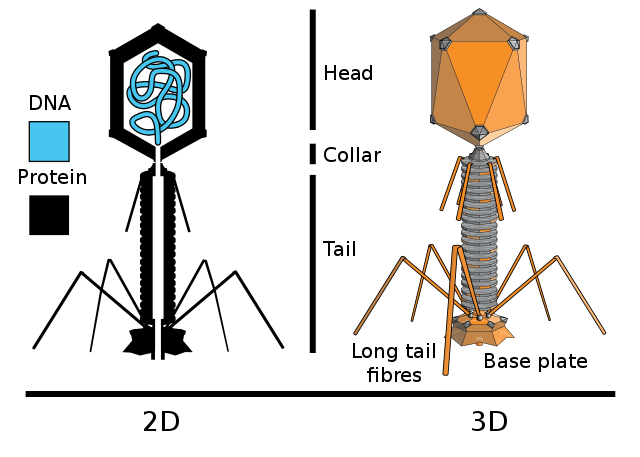This web page was produced as an assignment for an undergraduate course at Davidson College.
The repeated occurrence of bacteriophage outbreaks can spur the evolution of communication mechanisms and the balance between lysogenic and lytic infection strategies.

Bacteriophages, which are also known as phages in the scientific community, are viruses that specifically target bacteria to reproduce and multiply. These viruses contain DNA like humans do but are generally regarded as nonliving due to multiple characteristics such as the lack of cells, the lack of growth and development over time, and the inability to maintain homeostasis. In addition to these shortcomings, viruses are unable to reproduce on their own and instead require the use of host cells. In order to this, viruses attach themselves to the outer membranes of cells and inject their DNA, consisting of only a single strand, into the cell. (Roizman, 96) Once inside a virus can adopt different strategies for survival choosing between two reproductive cycles with varying effects on the host’s health and benefits. In the lytic type infection, a virus rapidly multiplies at the cost of the host cell’s health. In humans, this is the phase that leads to the symptoms of sicknesses being seen. Otherwise, a virus uses lysogenic infection where it remains inert and silent as it slowly replicates and multiplies. Interestingly, scientists have discovered in recent years that the reproductive strategy that phages decide to utilize can be directly influenced by communication from other phages nearby in regard to their host’s environment. This introduces the question explored by Doekes et al., how do these communications, and in turn, the reproductive decisions of bacteriophages, change over time as phages infect a population of bacteria.
Researchers in the 2017 study Erez et al. discovered that phages in the genus of viruses known as SPbeta are able to infect Bacillus bacteria and introduce genetic information that codes for the production of a signaling peptide known as arbitrium. This peptide is then secreted from the cell signaling that it has been infected by the phage. Interestingly, these arbitrium particles can then be used by nearby phages to make critical decisions when infecting other bacteria, namely whether or not to use lytic infection or lysogenic infection. When a phage of this genus infects a host, it is directly affected by the levels of arbitrium ions that are present outside the cell as they are taken inside the cell where they bind to the phage’s lysogeny-inhibition factors. The phage’s lysogeny-inhibition factors are responsible for stopping the phage from initiating lysogenic infection so when they are inhibited by arbitrium particles phages tend to trend more towards utilizing lysogenic infection. Similar systems of communication have also been found to exist in other types of phages that possess their own unique, exclusive signaling peptides. (Stokar-Avihail et al., 2019) Using this information, researchers from the Doekes et al. study created a mathematical model to better understand the evolution of these communication tactics.
To do this researchers used calculus and differential equations to represents a hypothetical environment containing populations of susceptible bacteria, bacteria that are lysogenically infected by phages, phages, and signaling-particles analogous to arbitrium. The lysogenic cells were modeled to grow and replicate like normal cells but eventually succumb to the effects of the phages and pop, releasing more phages into the environment. Lytic cells were modeled to burst instantly, releasing phages. Phages in the environment all had a set probability for which they may successfully infect a susceptible cell. Each infection was modeled to immediately release more of the signaling peptides into the environment to replicate arbitrium. These peptides were modeled to be absorbed by cells and then decay at a constant rate. The amount of free signaling peptide in the systems was used to calculate whether cells would be lytic or lysogenic upon infection. Researchers also examined a scenario where phages were taken from a population where phage and cell populations were at equilibrium and transported to a population of cells that had never encountered the phage before. This was done to simulate the introduction of phages to new environment and the large outbreaks that occur shortly afterwards.
Using their created models, researchers were able to compare scenarios where arbitrium-like communication takes place and those where it doesn’t. They found that when arbitrium communication was excluded from the model, phages with relatively low affinity for lysogenic infection were selected for. When arbitrium communication was allowed to evolve these phages were outcompeted by communicating phages that switched from a lytic strategy to a fully lysogenic strategy when around half of the available susceptible cells had been infected. By looking at the models where pages were transported from infected populations to fresh ones, researchers found that this occurrence worked best for spurring the evolution of arbitrium communication and the balance between lysogenic and lytic strategies. The model ensured that susceptible cells would always be available as new epidemics are occurring and led to a dynamic where multiple epidemic events occurred as phages were introduced to different fresh populations.
Using the information from this study, the next step should be to look at models of analogous systems by bacteriophages to determine whether to utilize lytic or lysogenic infection. One such system was found in VP882, a Vibrio cholerae infecting phage that listens to a population density sensing signal produced by its host bacteria, favoring lytic over lysogenic infections when the host density is high. Doing this would help to better understand the evolution of regulatory mechanisms in viruses
Khalil Miller is currently enrolled at Davidson College. Contact him at: khmiller@davidson.edu
References
Roizman, Bernard. “Multiplication.” Medical Microbiology. 4th Edition., U.S. National Library of Medicine, 1 Jan. 1996, www.ncbi.nlm.nih.gov/books/NBK8181/.
Doekes, Hilje M, et al. “Author Response: Repeated Outbreaks Drive the Evolution of Bacteriophage Communication.” 2021, doi:10.7554/elife.58410.sa2.
© Copyright 2020 Department of Biology, Davidson College, Davidson, NC 28036.
